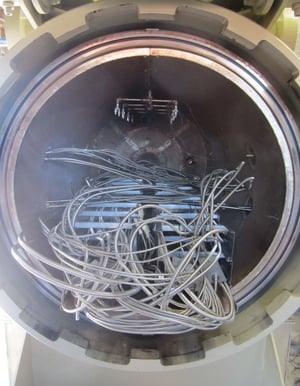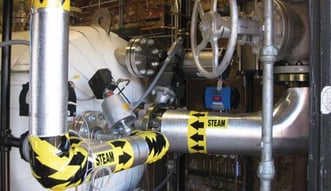 |
| Cables in FAI LOCA chamber |
Maintenance of aging components can extend their useful life. However, when either the maintenance becomes too costly, or the component wears out and/or is beyond repair – the component needs to be replaced. Given the robust designs of some components, some component lifetimes are greater than the longevity of the company that manufactured the component. Likewise, as technology advances, component models are replaced with new models that at times are not backwards compatible with existing models.
When a component needs to replaced and there is no off-the-shelf qualified replacement, there are three approaches which can be implemented: Commercial Grade Dedication, Reverse Engineering and New Replacement for an obsolete component. These three options offer considerable benefits including utilization of existing design documentation and component knowledge to identify/create a suitable replacement, establishment of a reserve inventory to facilitate future obsolescence needs, reduced downtime and ultimately, cost savings.
Commercial Grade Dedication is the process of taking an existing commercial grade component, which is identical to the component to be replaced, and performing a defined dedication process that will validate the commercial grade component for its intended use. Depending upon the component’s function and operating environment, this may be an effective method for updating components.
Reverse Engineering involves studying and analyzing a select component in detail to obtain a fundamental understanding of the device. It can also involve the physical process of taking the select component apart to analyze its geometry, design, construction and operation to identify the functional requirements of the component and design and improve an existing component or manufacture a like replacement to replace one that is no longer available.
New Replacement of an obsolete component with a new one that has similar or improved function and/or performance can become necessary when the original component or an existing replacement cannot be found. Replacement of an obsolete component with a new component involves a complete understanding of the component function and operating environment in order to design the new component either from scratch or by using select existing components. Depending upon the component function, an Equipment Qualification (EQ) process may be required.
Complete EQ solutions for the nuclear and industrial sectors obsolescence issues start with experienced engineers and technicians provide testing services using state‐of‐the‐art laboratories and facilities, including a Design Basis Accident (DBA) test facility that is capable of supporting current generation nuclear power plants along with the Generation III+ plants. In addition, extensive know-how of performing and supporting EQ programs provides a leading engineering lab with the proven experience to support all aspects of equipment and programs needed.
Comprehensive engineering and testing facility Fauske & Associates, LLC (FAI) provides critical support to nuclear equipment manufacturers and suppliers, OEMs and utilities with a range of services and testing designed to qualify equipment, parts and components for many applications. These include both mild and harsh nuclear environments to NRC guidelines and to meet industry and plant-specific requirements. Industrial applications in railways/railroads, aeronautical, automotive and many areas continues to grow.
 TESTING
TESTING
- Design Basis Accident
Our state-of-the-art stainless steel Loss of Coolant Accident (LOCA) chamber and test facility can easily achieve the required temperature and pressure transients representative of harsh environments for all existing and new Generation III+ reactors. In addition to our LOCA chamber, our High Energy Line Break (HELB) test facility is available to qualify components for mild environments. - Aging Services, Electromagnetic Compatibility (EMC), Electromagnetic Interference (EMI) And Seismic Qualification
We provide all testing and aging services to qualify components including thermal and irradiation aging, EMC/EMI and seismic qualification. - Activation Energy Determination, Material Testing, Forensics and Identification
Utilizing an extensive database of activation energies we can provide referenced activation energy values for numerous components. We also have a complete laboratory that can perform actual activation energy tests using one of our test instruments including micro-watt calorimetry, DSC, TGA and others.
Our material testing laboratory is also equipped with instruments including a Fourier Transform Infrared (FTIR) Spectrometer utilized for various applications related to Material Forensics and Identification testing to identify what the component material is and to perform forensics. Additionally, aged materials can be evaluated to determine the response of the material as a result of the environment conditions.
Material Performance testing is delivered using our INSTRON material property test rig which is able to perform industry standard tests including tensile strength and strain to determine mechanical properties of components.
- Consulting Services
Along with our testing services, we also provide engineering consulting services to assist with your qualification process. Our engineering services include determining solutions for components that fail or do not perform well during testing, and the ability to perform analytical calculations (thermal lag, seismic, radiation shielding, etc.) to properly account for environmental conditions at the equipment location. - Establish Actual Plant Normal Service Conditions
Using around the clock monitoring instrumentation, our engineers can establish actual normal service plant conditions (temperature, radiation, etc.). Actual plant conditions may be less than calculated design conditions offering improvement with the environmental conditions. - Establish Representative Temperature Profiles
If upper boundary maximum temperature conditions within a given room are the basis for your equipment environmental qualification, having representative time dependent temperature profiles could remove these conservatisms and margins. FAI can provide these time dependent temperature profiles using appropriate calculations and/or software tools. - Evaluation of Failure Criteria
An evaluation by our team can determine the particular types of accident conditions the piece of equipment being tested will need to respond to. For instance, if the specified equipment is required to operate following a High Energy Line Break (HELB), but not a Loss Of Coolant Accident (LOCA), the conditions corresponding to the HELB will be used to evaluate the corresponding environmental conditions, rather than defaulting to the generic “worst” case conditions. - Failure Modes and Effect Analysis (FMEA)
Our team can evaluate the overall effect on plant safety by evaluating the potential equipment failure modes of safety related equipment during the various stages of plant operation. If, for example, the selected piece of equipment does not impact the safe shutdown of the plant, potentially the piece of equipment can perform its safety function even though it may not be qualified for the environmental conditions. - Industry Experience Data Mining
Up-to-date Industry experience and databases are available to assess instrument qualification profiles. - Location Specific Evaluations
Rather than using a conservative broad zone to categorize the conditions a piece of equipment will be exposed to, we can determine location specific conditions. This includes the ability to perform thermal lag or radiation shielding calculations to properly account for equipment location. - Vendor Test Reports Data Mining
A complete review of vendor qualification reports can provide additional margin. In addition, if you have acquired a new revision of a particular piece of equipment, it may be possible that new qualification data may expand upon the qualified criteria.
Fauske & Associates, LLC (FAI) provides overall project management and Quality Assurance requirements for each project including the following EQ testing services:
| Existing Components | New Components | EQ Programs |
| Justifying Non-Qualified Components | Engineering Evaluation Testing | Testing Creation of New Program |
| Extending Qualified Life |
Activation Energy - Research and/or Experimental Measurement |
Auditing of Existing Programs |
|
Complete EQ Certification: 1. Determination of Activation Energies 2. Functional Testing 3. Thermal Aging 4. Radiation Aging 5. Seismic Testing 6. EMC/EMI Testing 7. IEEE-1202 Cable Flame Testing 8. QME-1 Testing 9. DBA Simulation |
Complete EQ Certification: 1. Determination of Activation Energies 2. Functional Testing 3. Thermal Aging 4. Radiation Aging 5. Seismic Testing 6. EMC/EMI Testing 7. IEEE-1202 Cable Flame Testing 8. QME-1 Testing 9. DBA Simulation |
Support On-going Programs |
|
Re-engineer Replacement Components |
Qualification for Additional |
Re-constitute Environmental Conditions |
Nuclear and industrial plants seek equipment qualification and obsolescence issue solutions on an ongoing basis. If you are interested in more content like this, subscribe to our nuclear technical bulletin below!

